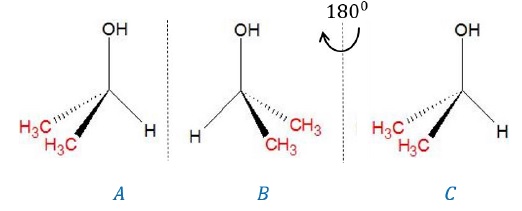Optical Rotation
The plane polarised light which is produced by passing ordinary light through Nicol prism is rotated by certain compounds when it is passed through their solutions. Such compounds are known as optically active compounds. The polarimeter is used to measure the angle by which the plane polarised light is rotated. It is called dextrorotatory (Greek for right rotating) or the d-form and is indicated by placing a positive (+) sign before the degree of rotation when the compound rotates the plane polarised light to the right, i.e., clockwise direction. Similarly, the compound is said to be laevorotatory or the l-form if the light is rotated towards left (anticlockwise direction). It is indicated by placing a negative (–) sign before the degree of rotation. Such (-) and (+) isomers of a compound is called optical isomers. This phenomenon is termed as optical isomerism.

Louis Pasteur made an observation in 1848 that crystals of certain compounds exist in the form of mirror images. This laid the foundation of modern stereochemistry. He demonstrated that aqueous solutions of both types of crystals showed optical rotation, opposite in direction but equal in magnitude (for solution of equal concentration). He believed that this difference in optical activity was associated with the three dimensional arrangements of atoms (configurations) in two types of crystals. Dutch scientist, J. Van Hoff and French scientist, C. Le Bel in the same year (1874), independently argued that the spatial arrangement of four groups (valencies) around a central carbon is tetrahedral and if all the substituents attached to that carbon are different; such a carbon is called asymmetric carbon or stereo centre. The resulting molecule is referred to as asymmetric molecule as it would lack symmetry. This asymmetry of the molecule is responsible for the optical activity in such organic compounds
Enantiomers tend to possess similar physical properties when it comes to, melting point, boiling point, refractive index, etc. They only differ with respect to the rotation of plane polarised light. If one of the enantiomer is dextro rotatory, the other will be laevo rotatory. Zero optical rotation is observed for a mixture containing two enantiomers in equal proportions. This is because rotation due to one isomer will be cancelled by the rotation due to another isomer. Such a mixture is known as racemic mixture or racemic modification. A racemic mixture is represented by prefixing dl or (±) before the name, for example (±) butan-2-ol. The process through which conversion of enantiomer into a racemic mixture takes place is known as racemisation.